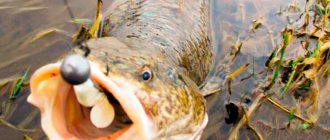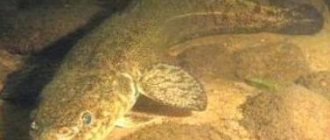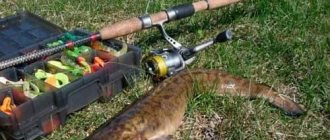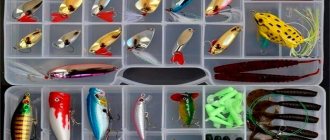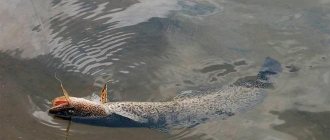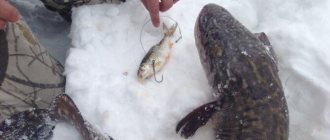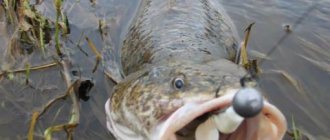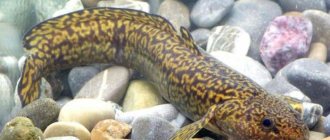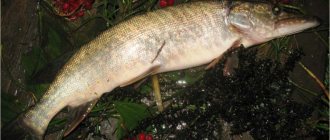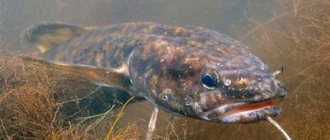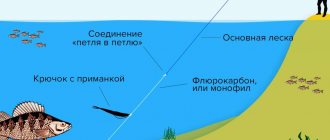We use skillful hands
Becoming the happy owner of this useful fishing device is very simple.
You can, of course, go to the store and buy everything you need - there is no shortage of “noise” spinners on sale, for example, from the Finnish one. But the Russian “left-hander” knows how to do everything himself, and not only a master craftsman, but also any person can make it on his own - you just need a little patience and, in fact, imagine how to make a burbot snitch. Now we will explain. First the simplest option. We will need:
- a small sheet of brass;
- a few centimeters of wire;
- two (or more) large hooks;
- lead.
We take a thin - 0.5 - 1 mm sheet of brass. Why brass? In principle, you can take bronze or red copper - all these are so-called “singing metals” that can ring loudly - it is no coincidence that bells are made from them.
The size of our sheet can be taken to be 60 cm long and 40 cm wide. We bend the sheet exactly in the center to get something resembling a gable roof. We drill a hole through which we thread the wire in both directions, not forgetting to leave an eye at the top through which the snitch will be tied to the fishing line. Two large hooks are attached to the edges of the wire
It is important that the hook rings and the main part of the forend should remain exactly under the fold of our “gable roof”
After this, the product remains to be turned over and filled with lead, and at the end, processed with a file to clean off all the roughness.
Strictly speaking, that's all - you can use it. Sometimes a metal ring is also attached to the top of the eye (the easiest way is to use a winding ring). The meaning of this improvement is that, when hitting the side of the knocker, the ring additionally produces sounds that attract burbot. Then such tackle is called a “ring”.
Cartridge knockers
Of course, the snitch does not have to be triangular. It can be made oval or square, and more than two hooks can be attached. Here, as they say, there is room for imagination and skillful hands to run wild. The main thing is that when it falls, it makes as much noise as possible, which will attract the burbot and force it to swallow the bait. Photos of burbot snitches can be easily found on the Internet. You can also use a double spinner, also known as a “clanger” - the operating principle is the same: make noise and excite the fish.
The most original way to modify a burbot hook with your own hands was proposed by a fisherman from Lipetsk, Ruslan Ostapenko. He added a couple of cartridge casings to the design. I made an ordinary triangular knocker, but in front of it I threaded a 12-gauge brass sleeve, sawn in half, onto the fishing line, and placed a 32-gauge sleeve inside. The result is a three-stage design, which creates even more noise when hitting the bottom.
Types of burbot winter lures
Regular winter verticals
For winter trolling of burbot, you can use the most ordinary verticals. The main thing is that they are large and heavy enough. A summer castmaster is also suitable for these purposes.
Heavy triangular
Finnish Kuusamo Madepilkki
Jigs
Special marine baits, jigs, have just the necessary characteristics. Finders (or finders) have become widely popular. This bait has balls inside that provide a sound effect. The hook is located conveniently - no matter how large the piece of fish on the bait is, when it falls to the bottom, the body of the bait will collapse and fall on it, making a much-needed knock.
Jigs
Finder
Hatchet
This, at first glance, strange invention is very suitable for catching burbot. She taps the bottom, and the nozzle does not interfere with this. For greater efficiency, you can attach a couple of small petals from summer rotators to it.
Baltic hatchet
Double spinner
Anglers often use summer double spoons. To burbot, you just need to disconnect the lower part of one of the halves from the winding ring. In this case, when twitched, the blade will open like a butterfly and then fold back with an accompanying tinkling sound.
Reworking the double oscillator
Homemade baits
Fishermen often make burbot baits with their own hands. Considering that the end result should be a heavy piece of hardware with a hook and, preferably, additional sound effects, this is simple. The simplest solution is a lead “spoon” with soldered hooks. Another option is an obliquely cut heavy tube, preferably bronze or brass, since these are the metals that will produce a louder sound when hitting a stone.
The simplest bait for fishing in strong currents
Homemade tube
Subscribe to the channel:
My YouTube channel RYBAFAN on fishing:
We're OK
Fishing in winter for burbot and lures
If this does happen, loosen the line, let it lie on the bottom, where it will calm down, turn around again, and try again. Don't forget to take a boat hook when fishing. Usually, with its help, all sorts of surprises that happen during fishing are resolved.
- Lowered - Raised - Dropped - Waited - Raised again, etc.
In order for catching burbot in winter with a spoon to be successful, you need to know about its features. The pause time should be from 5 to 15 seconds. The bait should play a little
Attract the burbot's attention by bouncing the spoon along the bottom. Tug the tackle a little, stopping at the bottom of the wiring
Some amateur fishermen use a non-standard fishing method. So, the spoon is drowned with a lead sinker and placed in the hole. The river carries the bait a certain distance. After this, the fishing line is wound with careful movements of the fishing rod. This trolling tactic is only suitable for reservoirs with a completely clean bottom.
In summer, there is a large amount of live food in the waters, so lure fishing is not considered effective. But from autumn until the end of winter, when shoals of small fish leave the coastline, burbot is well fished for using spoons.
One of the types of gear that requires active participation from the angler is winter gear for burbot. The knocker consists of the following components:
- standard fishing rod;
- monofilament line with a diameter of 0.12-0.25 mm;
- hook No. 10 with a weight on the winding ring.
It is worth noting that, according to fishermen, the snitch has a different appearance, and the following gear is used for its manufacture:
- heavy balancer;
- jig head with a large sinker;
- hook with turtle weight.
Important! The knocker should have a good weight of about 30 g, so that when you move the rod, it taps on the bottom and produces a characteristic sound. The main thing here is to attract fish to a specific place, and then it comes down to the bait
Fishermen still do not understand what attracts burbot in the sounds produced by the snitch
The main thing here is to attract fish to a specific place, and then it comes down to the bait. Fishermen still do not understand what attracts burbot to the sounds produced by the snitch.
Perhaps these are infrasound waves from knocking on the bottom of a reservoir, or he is attracted by an incomprehensible object that produces vibrating sounds. Basically, a snitch is needed for a body of water where you have to fish in places with a rocky or clay bottom.
A muddy pond is not suitable, because the bait will fall into the mud without making any sounds.
From season
The best time to catch burbot is from mid-October to early May. Burbot is most active during the cold season. A break in fishing may occur during spawning.
In the summer, it is almost impossible to lure burbot out of hiding; the fish is very sleepy and does not bite well. The best time in summer is cloudy, cold weather. You can use dead and frozen fish, frogs, and worms as bait.
A good time to catch burbot is early spring. In bad weather, you can count on a larger catch here than when fishing on a clear day. But it is best to catch burbot at night, because it is at this time that he is not very picky about food; he is also attracted to worms, frogs and any fish.
Winter is the ideal time to catch burbot, and this time should also be used to look for fish sites. Thanks to ice, you can try many places and find out exactly where the fish are. In winter, you can catch burbot with almost any bait: live bait, worms, shrimp, meat.
From the gear used
The most popular gear used in winter is winter bottom fishing rods. If fishing is passive, then they use girders. You can use any fish, worms, chicken giblets, or shrimp as bait. For winter fishing, you can also use tackle for the last vertical lure. Here you can use fillets of any fish, larvae, frogs, worms.
Do-it-yourself spinner for burbot
In order for the burbot catch to be large, you need to choose the right bait or make your own bait . For any fisherman, there is nothing better than choosing the best option for making a spoon from scrap materials, and almost everyone has the elements that we will use.
By making spinners yourself, two main goals are pursued:
- Saving money;
- Production of baits that best meet the requirements of the fisherman.
The simplest do-it-yourself spinner for burbot in winter is vertical . Firstly, it is very easy to make. Secondly, it is perfect for a good catch.
To work you will need:
- Working tools (hacksaw, soldering iron, needle files, etc.);
- Sheet metal.
Are you interested in Williams spinners for winter fishing? In this article you will learn how to properly fish with this brand of spinners.
This article will tell you how to make a spinner with your own hands at home.
Metal plates can be any (nickel silver, brass, copper). One important rule is that after polishing they should shine well . Thickness – 3-5 mm. You can make several spinners of different weights and colors to experiment with while fishing.
Two different types of sheet metal are taken and blanks that are identical in shape and size are cut out. The plates are tinned, protected and soldered together. It is very important to ensure that its weight at the bottom is not much greater than at the top. Otherwise the balance will not be optimal .
It is recommended to solder the hook between two plates - this way it will sit more securely. A hole is drilled on the second side and a winding ring is installed to which the fishing line will be attached.
Two blanks can be riveted together, leaving them movable. This will give a positive effect when they tap each other. This result can be achieved by drilling holes on the top and bottom of the plates and connecting them with rings, to which the hook and line will also be attached.
We also present to you an alternative option for making vertical lures for perch in this video.
https://youtu.be/zYf9GCZToys
Recommendations
Tips for catching burbot:
- in addition to a well-developed sense of smell, burbot actively uses the lateral senses, picking up minor vibrations in the water;
- At night the fish are most active. Often it is night shallow fishing that gives positive results;
- burbot swallows the bait heavily. If it is difficult to get the hook, it is replaced with a new one. Have a few spare leashes with hooks and an extractor with you;
- caught fish is better preserved on kukan;
- use a glove to remove the catch from the hook;
- there is no need to cast the tackle to great depths;
- when fishing at night, a fire on the shore will help activate the burbot;
- due to the deep swallowing of hooks by burbot, experienced fishermen refuse to use tees;
- To achieve positive results, feed the fishing spot for several days before fishing.
Originally posted 2018-04-04 14:15:51.
How to catch burbot
Burbot is considered a curious fish that prefers to look for food at the bottom of the reservoir. Many fishermen even noticed that at night it reacts well to the light of a lantern or fire. And if you go fishing for such fish, then you should look for it:
- in clean water;
- in places with a hard bottom;
- in places away from human activity;
- in coastal cliffs;
- in burrows;
- in whirlpools;
- under the piers;
- in places where snags provide shelter for him.
It is worth noting that burbot loves cool water so much that it even spawns in winter. Everything is due to the fact that its life processes actively work at a temperature of -10 C.
Based on this, we can describe several periods of feeding of this fish. It is during this period that his digestive processes work very actively.
- In the fall, starting in October, when ice forms, the fish begins to mate and its appetite awakens.
- All winter the fish is looking for food and is ready to pounce on any snitch.
- In spring, zhor continues until May, including the spawning period.
The current in a reservoir is an equally important factor in the presence of fish. And if there is no current, burbot will not be found there. It tries not to migrate across the reservoir and remains in its usual habitat. Therefore, knowing where the fish were found, you should look for them in the same places.
There is even an opinion among fishermen that burbot has its own trails. When they move in a flock along a strictly defined route, the fisherman, once on this path, will leave with a large catch. Usually such trails are searched for through newly formed ice.
As a rule, only burbot is caught using snitching, although some people prefer to catch grayling or taimen. By choosing a certain tactic in a catchable place and playing with bait, you can pull the fish one after another.
In the summer (from the end of August) and autumn, various types are used to catch it.
sneak peeks
. By the way, if there is open water in winter, this method also brings good catches.
You need to catch it only at night, preferably using several gears.
It has been noticed that the worse the weather, with strong wind and rain, the better the burbot bite.
You should have several spare leashes equipped with hooks with you. Very often, when catching burbot, it is easier to unfasten the leash and put on a new one than to try to pull out the bait. He swallows it so hard.
Winter burbot fishing begins about a week and a half after freeze-up. In winter, burbot no longer wanders throughout the reservoir. At this time, it is already moving in flocks to its spawning sites. Now it can be found in the beds of various channels and rivers along which it moves to spawn.
Most often, burbot is caught on bottom fishing rods, with a jig or spoon. When fishing passively, girders are often used, and quite effectively. But the main gear is still a fishing rod with a spoon or jig.
It is best for burbot to take on white spoons, the size of which is similar to the fish that it usually feeds on at this time. And these are usually pipe cleaners, about 7cm long.
And since all the other fish in the reservoir are sluggish, the burbot is used to seeing them like this, then the game of the spoon should not be active, make the game smoother. You should also not raise the spoon higher than 30 cm from the bottom; it should be located directly above the bottom, since burbot feeds exclusively in the bottom layers.
It’s also worth twitching the lure periodically. When the spinner takes a horizontal position for a certain period of time, the likelihood of a burbot biting increases.
Burbot fishing technique
There are several good ways to catch burbot - these are baits and spoons. It is with their help that you can get prey in the shortest possible time. But for success you need to choose the right gear, bait and know the fishing technique.
For the spinner
Many fishermen prefer to catch burbot using a spoon, because it is much more effective than other fishing methods. Before fishing with a spoon, you need to choose the right equipment so that no unpleasant unforeseen situations arise.
Fishing gear
Since the burbot is a fairly large predator, the gear must be strong and durable so as not to let you down at the most crucial moment:
- Take a fishing rod that is strong and reliable so that it can withstand resisting prey; the handle should fit comfortably in the hand;
- The diameter of the fishing line is not less than 0.4 mm;
- Leash length is approximately 10-20 cm;
- Hooks must be strong, with a long shank and large in size, approximately No. 12-14;
- Since spinners are used, additional weights are not needed;
- You should take a medium-sized lure, you can take any color, but fishermen say that it is better to fish with silver ones;
- To increase the chance of catching a predator, you can put a piece of fish on the lure.
Spinner game
A very important point is the play of the spinner. After you have decided on the fishing spot and drilled a hole, the spoon can be lowered to the very bottom.
The action of the bait should go smoothly, from top to bottom, or slightly to the side. You shouldn't raise the spoon high, it can only scare the fish. Also, making sudden movements or making the game too complicated is also not recommended.
You need to raise the bait at a distance of 10-30 cm from the bottom - this is the most catchy option. If there are stones at the bottom, you can lightly tap the lure on them. This will attract burbot much more effectively.
Bites and fishing
When the fish starts to bite, this is expressed in very characteristic and sharp twitching of the fishing line. You need to hook with sweeping movements and very strongly. Once the fish is caught, it practically does not resist, but the closer to the surface of the water, the more the burbot will resist, realizing that something has gone wrong.
At this moment, it is very important to hold the line and prevent the prey from swimming away. And this is difficult, because the individual is large and has a lot of strength
When the head appears in the hole, you need to grab the gills and pull it out onto the ice.
There is no other way to pull it out, because the fish’s skin is very slippery. When you fail to capture it and the prey goes under the water, you shouldn’t rush to pull it up, wait until it swims almost to the bottom, and only after that you can start fishing again. When the fish is pulled onto the ice, it is worth stunning it.
To the girders
Fishing with girders in December is the fastest and most effective way to catch this predator. You can fish in several ways: put this gear on all night and check it only in the morning, or periodically check it all night. Some fishermen light a fire, because it is believed that the light is very good at attracting burbot.
How to install the girders?
Having found a deep hole, you need to move a little away from it and drill a hole at the exit from it. The hooks are placed from the very shore, in a place where there is a slight current. You need to make several ice holes, at a distance of several meters from one another.
To install the vent, you must complete the following steps:
- Make a hole measuring 30 by 30 cm;
- Make another one a little further upstream, where you should lower a pole, the length of which is a little more than a meter.
- A thick fishing line with a load of 100 g is tied to the end of the pole;
- After this, you need to take a wire with a slightly bent end, two meters long, and pull the line into the main hole.
- When a little time passes, such a pole will freeze into the ice, and the fishing line will remain in the water, and when it is necessary to check the girder, then when the ice breaks, the fishing line will remain intact. In addition, it will be much easier to pull out the prey through such a hole;
- You need to tie two leashes to the hook: one for the weight, and the other a little higher;
- The leash can be made from strong fishing line with a diameter of 0.5 mm. The length of the leashes is 60 cm and 40 cm. After the live bait is put on, the tackle is lowered into the water;
- The hole must then be covered and covered with snow. Use a piece of foam or plywood to cover.
Bait
It is better to take live bait as bait, for example:
- Goby
- Gudgeon
- Ruff
- Smelt
If there are no such fish, you can take any other one. The main thing is that it is fresh, because burbot will not be tempted by stale bait.
Also, as a nozzle for vents you can use:
- Chopped meat
- Fish fillet
- You should not use summer baits for fishing in December, it will not bring any results.
Search for burbot
It’s not enough to know what and how to catch burbot. You need to be able to find a promising place, otherwise you may be left without a catch. If this is a familiar body of water, then fishermen in the distant past knew where to look for fish, but if this is an unfamiliar body of water, then significant troubles are likely. Despite the fact that, in our time, at a time when compact echo sounders appeared, this is not a problem and it is possible to quickly find the location of a given fish, despite the fact that for this you need to drill many holes. For this reason, we can safely say that winter fishing is, first of all, hard work and only after that rest, and rest at home, in comfortable warm conditions.
Burbot trails
Burbot is a fish that migrates through a body of water along its own paths, which is why various oddities happen during fishing.
Interesting fact! A local fisherman from one of the villages located near the Sylva River managed to catch a whole group of lures. This is despite the fact that there is quite a lot of burbot in the river. According to a local fisherman, he managed to make a hole right above the burbot trail.
Based on this, there are often moments when one angler is actively catching burbot, but a couple located nearby have not seen a single bite during this time.
What is the “burbot trail”?
The burbot's lifestyle is dictated by its feeding method and its physique. The massive head and wide mouth allow it to cope with important prey. Also, there is enough space in his body to digest this prey. Burbot has a long, ribbon-shaped tail, which allows it to feel great on the surface of the bottom. Unfortunately, such a body composition does not allow it to actively move in the water column, and especially in the current.
For this reason, burbot stays away from fast currents and prefers quiet places with a weak current.
Before the start of spawning, when the burbot begins to look for places to spawn, it overcomes the rifts, but does it wisely. He finds places where the current is not so swift and forces such obstacles. He finds such places on the sides of the rifts or near the shore, if the distance between the bottom and the ice allows him to do this.
Before crossing the riffles, packs of burbot plan to have little rest before the next move forward, since this requires expending a lot of strength and energy. In most cases, they constantly move along the same route, which fishermen call a “path”. By the way, this is typical not only for burbot: each species of fish has its own “paths” along which they move in search of food. When the path along which the fish moves is found, it is possible to constantly have a catch, and at the same time, not small specimens are caught on the hook.
For skilled fishermen, this is not at all an easy task; it is enough to estimate where the boundary of the stream ends. Then they drill a couple of holes and determine in which of them the spoon does not drift over the edge of the hole. The thickness of the ice can also indicate the prospects of a place: the thicker the ice, the weaker the current in this place, respectively, this place may be promising.
When the burbot spawns, they go looking for burbot in completely different places and mostly at depth, but in any case you won’t find it on the current.
This behavior is not typical for burbot during the daytime, because at this time of day it mostly rests in areas where the depth is not too great and where there is enough oxygen brought by the current.
Locations of burbot at different times of the day
At a time when winter has not yet entered into force on reservoirs and has not covered them with a thick, reliable layer of ice, burbot during the daytime, in most cases, is in shelter and actually does not feed, waiting until it gets dark. During the winter period, burbot can also take bait during the day if the fisherman finds a place where the fish is staying and puts the bait right under his nose. Under such conditions, you can count on productive fishing.
Regardless of this, fishing at night will still be more effective, since at this time the fish’s appetite constantly increases, which is associated with the peculiarities of its behavior. In the daytime, burbot can study the bait for a long time and, in the end, may refuse it, but at night he grabs it without wasting time studying it.
Burbot is caught just as actively before spawning, but only early in the morning and late in the evening. In the middle of the night, its activity drops to virtually zero. At the end of spawning, burbot behaves actively all night, without breaks.
What is the result?
The result can be presented in the form of a picture located below in the text, which indicates in which areas of the reservoir it is better to look for burbot in the winter.
Approximate winter sites for burbot on the river. Daytime stops: 1 – under the riffle, next to the main stream; 2 – at the exit from the pit. Places for night feeding of burbot before spawning: 3, 4 – shallow waters. Places for night feeding of burbot at the end of spawning: 5 – beginning of the pit; 6 – middle of the pit, closer to the main jet; 7 – protrusion of the coastline.
This is what concerns reservoirs with a current, but in reservoirs with stagnant water everything is much simpler: before spawning, burbot prefers shallow water, and after spawning, it prefers depths and other areas of the water area.
How the moon affects the behavior of burbot
Burbot is a fish that reacts very actively to the moon and its absence.
Transformations in the behavior of burbot are already felt when a narrow moon appears in the sky. As the night light rises, the burbot's bite becomes less confident, and when the full moon comes, it generally stops biting. This lasts until the new moon occurs.
Note to anglers! When going fishing for burbot, you must definitely take this factor into account. At the moment, it is not difficult to determine on the Internet at the time when the moon rises and at the time when it sets, as well as what quarter of the moon.
Burbot is one of the most interesting fish inhabiting our drinking water bodies. At a time when the bulk of fish go to winter at enormous depths and emerge from the pits only during winter thaws, the “golden” time begins for burbot. The same can be said about some of the fans of winter burbot fishing, for whom there is an opportunity to catch a fairly weighty specimen. All that remains is to prepare without jokes, armed with reliable gear and equipped in accordance with all the rules. For greater efficiency, it doesn’t hurt to stock up on live bait in the fall, since it’s not so easy to get it in the winter. For anglers who practice this type of fishing, this does not pose any difficulty. In extreme cases, it is possible to catch live bait in the daytime in the same body of water.
For those fishermen who prefer to catch burbot using unnatural baits, it is enough to stock up on catchy spoons and patience, endurance and willpower, because you will always have to be in difficult weather conditions. Despite the fact that for real, avid lovers of winter fishing, no weather conditions, even the most severe, are an obstacle.
Burbot: Briefly about Fish. Appearance
Burbot (Lota Lota) is a freshwater fish of the cod family. It is a fish with an elongated body (similar to a catfish). Burbots come in a variety of colors. There are individuals of black or dark brown color, and olive color with marbled dark rings.
— The head is small, with teeth located in one row on the upper and lower jaws. There is a mustache on the chin; — Of the two fins on the back, one is elongated, almost to the tail. The lower fin is medium in length; — The tail can have either a rounded or pointed shape; — The color of the chin, as well as the ventral fins, is whitish.
Burbot sizes also vary widely. Most often 30-40 cm, weighing from 1 to 3 kg. There are also larger ones - according to some data, burbots can reach sizes of about a meter and weigh 20-30 kg. The largest burbots live in cold and deep-sea reservoirs.
What does burbot eat?
The main prey that burbot hunts are benthic inhabitants of the bottom, mainly gudgeon, however, burbot is an omnivorous fish and eats everything it can find from animal food, including not the first freshness.
We recommend: How to make a spoon from birch bark
The burbot diet mainly includes:
- Fish living at the bottom of a reservoir;
- Invertebrates;
- Fish caviar.
The search for food and feeding of burbot begins at dusk and continues throughout the night.
In winter, burbot feed most actively, since during this period they have a spawning season; in summer, the amount of food consumed is sharply reduced.
The presence of gudgeon in a reservoir may be an indicator of the presence of burbot, since it is the main food source for burbot.
Necessary gear for catching burbot with a step
— For fishing with this method, it is best to use a winter spinning rod and a small baitcasting reel.
— It is better to use monofilament fishing line, with a diameter of 0.2-0.35 millimeters.
— You need to attach a swivel with a carabiner to the end of the fishing line.
— A “Cheburashka” type sinker is attached to the carabiner, on the second edge of which a leash with equipment for live bait is attached. Thanks to the fact that a carabiner is installed, it becomes possible to quickly change the weight of the sinker. This need arises when the fishing location changes from deep to shallow, or from fast to slow currents and vice versa.
— It is necessary to select the weight of the sinker in such a way that when lowered to the bottom and between taps, the equipment is carried away by the current by 1-2 meters. And also the knock of the load on the bottom should be noticeable in the handle of the spinning rod. If the load is light for a given current, then there will be no knocking, and the bait will simply be carried away by the current.
Sometimes burbot takes well to the smooth movement of the equipment; the most important thing is not to make sudden movements so that it has time to swallow the bait.
This equipment has one significant advantage, and its essence is that the angler can leave the rod on the ice and move to another hole. And the live bait that is located at the very bottom will continue to flounder in the current, thereby provoking the predator to attack.
Naturally, the question arises: What if a predator bites and steals the rod?! — Yes, such cases are not uncommon, so when leaving the rod on the ice, we advise you to secure it. This can be done using tent screws and a simple rope.
Since the methods described above differ in activity (the first is passive fishing, the second is active fishing), they can be combined with each other, thereby achieving greater success.
For both the first method and the second method, the holes are drilled in the same way.
Sometimes, near the places where the vents or installations are installed, it is necessary to drill a hole and tap the bottom. A burbot, interested in a knock, will either bite on the “step” or bite on the girder.
Very often burbot is caught in places where there are toothless fish. Since they form the diet of carp fish, large fry are always kept nearby. You can determine the presence of shellfish at the fishing site using a heavy spoon, dragging it along the bottom.
Often, burbot is active in those places where it was caught well in late autumn. If you manage to find a similar point in the fall, then it is better to remember the landmarks and come to this place in the winter. The bite will be guaranteed.
Thank you for your attention! No tail, no scales, fishermen!
About the flashing of burbot
Communicating with anglers, I got the impression that 90% of them have never caught a burbot themselves, but they know exactly how to do it. There is also a certain group of “specialists” who believe that it is generally impossible to show off a nocturnal predator. Therefore, I will dwell on the basic principles of flashing burbot in more detail. Flashing always occurs at a distance of only 120-200 mm from the bottom, however, it develops according to the classic scenario: rise, reset, pause, rise. The spoon should be moderately light and wide, and when released, move to the side (or plan) by at least 150 mm. (Of course, you still need to get used to spinning at such a distance from the bottom.) It is desirable that the spinner, passing its lowest point, lightly scratch along the bottom, raising a small cloud of turbidity and creating an additional sound “design”. There is no point in knocking loudly on the bottom (especially rocky ones), since burbot is afraid of too loud a sound and always leaves.
The pause after resetting the spinner is kept from 5 to 15 seconds. If the interval between swings of the fishing rod is less than 5-7 seconds, then the predator may not take at all, even if it is nearby. Large burbot almost never rises from the ground more than 0.5-1 m, although small burbots in some cases can react to the play of a spinner located 1.5 m from the bottom surface. There is another fishing tactic when the spinning of burbot is no longer smooth swings and sharp drops of the bait, but rather short pushes with a fishing rod. The spinner tugs the bait, moves it, and forces (additionally) to move at least a few centimeters to the side from its initial landing spot.
If the burbot takes it sluggishly or if its concentration in the place of fishing is small, then trolling without adding a tail or a sleeping fish is useless. After replanting a sleeping fish, the following changes occur in the trolling tactics: after dropping the lure, the tip of the fishing rod is pressed to the hole. The spoon with the attached fish moves as far as possible to the side. After this, slowly, with short stops, they pull her towards them. The movement of the spinner can be either uniformly progressive or accelerated. The greatest effect comes from baiting the spinner with the tail half or simply a fresh, unfrozen ruff. In some cases, the effect is achieved by simply moving the bait. A spoon with a ruff is “put” in a vertical position, and then lowered into a horizontal position. It is impossible to say which manipulations with the spoon provoke the predator more, since in different cases the burbot gives preference to one or another game of the spoon.
CATCHING BURTOB WITH A WEIGHT ON A JIG A weight of burbot is most often caught with a heavy jig weighing from 7 to 15 g. The basic techniques for shadberry using a heavy jig are not much different from the techniques for fishing with a spoon, the only difference being that hooking a fish onto the jig is mandatory, and tapping the bottom should be even more careful. FISHING WITH A TACKLE A tackle can sometimes be more effective than a spinner or jig. The best tackles are those in which the tail of the fish remains free, not constrained, and the hooks do not cling strongly to the protrusions of the bottom. The best attachment for the tackle is the same brush. It is quite enough to place the ruff under the head with a hook No. 10-12 or a double hook No. 7-8. The sinker is one or two olives located on the fishing line above the hook. The principle of fishing with a tackle comes down to simply moving or tugging the fish in the lower layers of water or dragging the latter along the bottom. It is quite acceptable to leave the tackle on the bottom without moving for 10-15 minutes. Burbot is also caught on a regular float rod, using a ruff or gudgeon as bait. The equipment of a float fishing rod is practically no different from the equipment of the winter version of the fishing rod with an olive sinker lying on the bottom and a leash made of fishing line up to 350-400 mm long.
* * * Summarizing the data on the habitats of burbot and the difficulties it experiences in the summer, one should not assume that the open water season for this fish is always an extreme situation or a disaster. Thus, in the Northern Dvina, burbot fishes almost all summer. On numerous shallows formed in places where the main channel bifurcates, as well as behind the islands, where there is practically no current, it is a definite obstacle when fishing for bream and other white fish. In the north, in general, burbot is treated as a trash fish. Arkhangelsk fishermen even say that sometimes you can get rid of annoying burbot only if you change the place of fishing. In small rivers, as well as in shallow bays in the summer heat, small and even medium burbot (up to 1.5 kg) are essentially doomed to survive . He does not go anywhere from his usual habitats and, with severe oxygen starvation, he simply has no time to eat. But large burbot struggles for life as the water warms up in its own original way. In deep rivers or flowing reservoirs, burbot from 2 kg are able to reach the riverbed or lie down in a pre-channel hole at the maximum possible depths.
Even in the most intense heat, the movement of various layers of water takes place in such a way that the “thermocline” effect operates in the middle or even in the upper layers of water, and at a decent depth the bottom fish feel quite comfortable. On the Istra Reservoir in mid-July, live bait holds a depth of only 1-1.5 m. Bream is caught all summer at a depth of 5 to 14 m, and often deeper. Large burbot, with an increase in water temperature, moves to depths of 10 to 20 m. There it occupies areas most suitable to its usual habitat conditions, and practically never stops feeding throughout the summer. At depths of 10–15 m, as a rule, groundwater emerges and the temperature throughout the year does not exceed 12–13°C, which is very acceptable for the predator. Naturally, each body of water has its own individual temperature balance and there are areas of the territory where the water is always colder. Thus, an underwater hunter in certain places of the reservoir, when diving, literally cramps his legs. Even on hot days on one body of water, the temperature difference can vary from 5 to 10 ° C. And in conclusion, I would like to remind you that on every large body of water there are places where burbot are caught almost all summer. Very often they are found next to dams, bridges, near dams, at the confluence or confluence of rivers or channels. In northern rivers, where the water temperature in summer rarely exceeds 10-12 ° C, burbot can be active at depths of 0.5-1 .5 m.
Tactics and fishing techniques
At night
The tactics for catching burbot is to search for burbot trails or predator sites. On rivers you can navigate along the coastline, i.e. look for places with reverse currents, lulls, landfalls and shoals. It is more difficult to find fish in stagnant bodies of water, especially if this body of water is unfamiliar to the angler from summer fishing.
The fishing technique involves the use of several fishing options:
- Active search for a predator with a spinner or hooker. You have to fish in the dark, and you can’t do without a good flashlight. During the search process, the fisherman should record in memory all changes in depth. With some experience, you can also determine the nature of the bottom. It is advisable to record the points where bites occurred in the navigator’s memory and periodically return to them, and it is not necessary to fish exactly on those holes - it is better to explore the area around them.
- Arrangement of passive fishing gear: zherlits, postavush or donok. When arranging gear, you need to focus on the depth, i.e. look for certain changes. On an unfamiliar body of water, especially on a lake or other standing body of water, fishing gear can be placed from shallow to deep or in a checkerboard pattern. During the fishing process (if, of course, there is at least some bite), the gear should be moved closer to those on which the fish was caught.
- Combination of active and passive fishing. This method allows you to quickly find promising places for fishing and there is no need to spend the night in a tent.
During the day
During the day, you should also look for burbot, but preference should be given to active fishing methods: fishing with a jig, lure or hook. During the day, burbot often stays at depth even during the pre-spawning period.
Bite
When fishing with active tackle, the burbot bite is expressed in two ways - it is either a powerful blow to the hand, or a weight hanging on the hook. The burbot may not peck so violently on a jig - often it simply bends the nod downwards. It should be cut anyway.
Fishing
Burbot is not the strongest fighter, but it has one feature that often complicates fishing. When dragged to the hole, the burbot can twist its tail around its body and getting it into the hole becomes very problematic. Therefore, it is recommended to use forced fishing.
Selecting the fishing period
Anglers specializing in freshwater cod fishing claim that the most successful fishing for burbot is by tapping on the first ice. This fact is due to the fact that the period of the beginning of freeze-up often falls at a time when burbots are preparing for spawning, fattening and actively feeding before breeding. As a rule, this time begins at the end of November and active burbot fishing continues until the third ten days of December. Then, sexually mature burbots stop feeding for a month, and the fisherman is content with catching small individuals. Fishing by knocking is slightly less successful in February and March. The last ice is not as successful for burbot as the beginning of the season.
Need to catch at night
The fisherman should not forget that the predator is nocturnal and is active even in an ice-covered reservoir at night. It is better to catch burbot at night in winter. During the day the chances decrease. Moments when the atmospheric pressure changes, leading to changes in the weather, are suitable for planning a trip to a reservoir in order to catch a predator by tapping. In stabilized weather, the bite is not uniform, the fish bite at exits and large specimens are not noted in the catches. An important condition for successful fishing is the search for burbot trails, along the trajectories of which holes are drilled by tapping the bottom underneath them.
Where and when is the best time to fish with a snitch?
Burbot lives in the European part of Russia except for the southern regions. It can be found in the Volga and its tributaries, in lakes of the same places. But its population increases as it moves north. And the cold Siberian rivers flowing into the Arctic Ocean can be considered the kingdom of burbot. Catching burbot in the Yenisei and even Lena basins is not fishing, but fishing.
Burbot live in one chosen place constantly, but to feed they swim out of it and move along the same routes. Success will be to discover the permanent habitat of burbot. From there it’s easier to lure them out with a snitch. Although this fish never flocks together, the path does not belong to one individual. This is a promising feeding route for many.
Here are approximate guidelines in search of a habitat, next to which there are burbot “paths”:
- You shouldn’t look for holes with a silted bottom, but still the depth should be considerable;
- Places completely littered with snags or a completely clean bottom without any obstacles are not suitable;
- deep place with a rocky bottom. Several snags, driftwood or a pile of stones;
- It is advisable to look for a place with running water. But not on the current itself, but a little away from it or behind cover, for example, behind an island or a bridge support.
It is best to start looking for a suitable place in the summer. In winter, the selected landmarks change shape or are not visible.
The greatest chances of catching burbot occur during the following periods:
- from October until the beginning of the freeze-up;
- three months of winter excluding spawning time. The exact beginning and duration of spawning is different everywhere. For example, in the Moscow region, burbot fishing is prohibited from December 15 to January 15;
- from the beginning of the flood until April.
This predator hunts in the dark. Some traders believe that not the night itself, but the evening twilight is the best time for catching by knocking. It is worth starting the fishing of promising places before dark, so that by dark you can already attack the burbot trail or place of permanent “residence”.
Fishing place
Unlike the same pike perch or pike, finding burbot without knowing exactly its stopping and feeding places is extremely problematic. In the case of this fish, search fishing brings good results relatively rarely. Before going out specifically for burbot, you must either already have successful fishing experience in this place, or have fairly accurate information obtained from familiar anglers. Traces of fires on the shore can also serve as a guide to finding a fishing spot (unless it is a favorite picnic spot). If we talk about the places where burbot most likely lives, these will be rivers with clean water and constant recharge from cold springs. This fish prefers a rocky bottom, as it is easier to find shelter on it. Burbot can also be found in places where the roots of trees from a steep bank go under the water - this is also a good shelter for this fish. When fishing at night, you should pay attention not to the burbot’s camp sites, but to the shallows located not far from them, where the fish come out to look for food when night comes. If fishing takes place in late autumn, when the air temperature is already close to negative values, you can find burbot in almost any part of the reservoir - the fish is preparing for spawning, it has a glutton.
What to hang on a hook if there is no bait
You, friends, can read about the preferences of burbot and what I prefer to use to catch it in the article “What is the best way to catch burbot in winter?” Now I want to share with you information that will help you when there is no suitable bait. I understand that this is a specific bait, but you still need to have different bells and whistles in your fishing box. Yes, as a last resort.
Smell plays an important role in catching burbot. No one forbids having a couple of bottles of oils with you. I carry a little fir and valerian oil with me. I saturate a piece of sponge and put it on the hook. Sometimes I just get by with a fragrant sponge. The main thing is not to overdo it. Otherwise, you have to wastefully rinse the spoon along the bottom for some time until the concentration of aroma returns to normal.
A snitch equipped in this way sometimes helps out. Even with dried loach, spruce or grayling heads, a scented sponge is capable of making a splash among the burbot stock.
Spoons, wobblers and foam rubber
With good fishing skills, you can catch burbot in the bottom layers using rotating or oscillating spoons. True, such fishing has a number of problems. The lure needs to be driven as close to the bottom as possible, and with such a drive, not all models retain the game, and the likelihood of a snag is high. Therefore, spinners are rarely used for autumn fishing. Good results can be achieved by using wobblers with greater depth. Such baits are easy to recognize by their large blade. It is better to give preference to suspenders, since burbot prefers slow retrieves with pauses, but it is still advisable to have both sinking and floating models. Simple baits such as foam fish can also be catchy. In addition to the seductive game, such a fish has several other advantages. Firstly, foam fish are easy to make and you can make them yourself in large quantities. Secondly, the catchability of the bait can be enhanced by impregnating the foam rubber with an artificial or natural flavor. Thirdly, you can reduce the number of hooks by simply hiding the hook tips in the bait itself. Important! When fishing at night, it is advisable to have a supply of batteries for flashlights, since in cold weather the batteries discharge faster.
